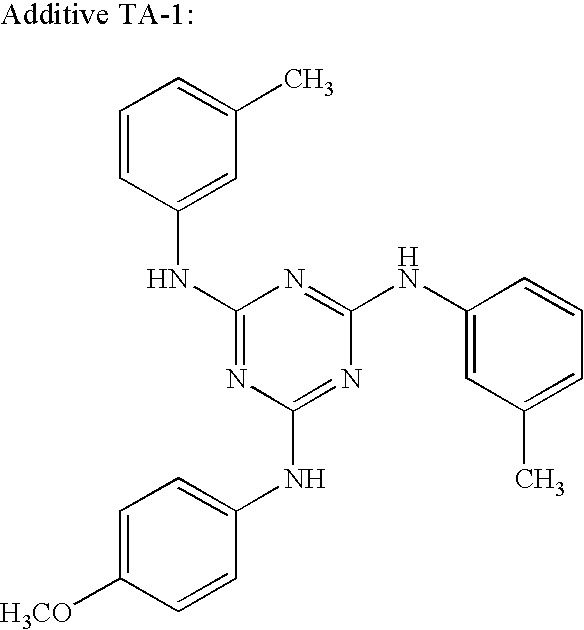Polymer film, and phase difference film, polarizing plate and liquid crystal display device using the same
a technology of phase difference film and polymer film, which is applied in the field of polymer film, can solve the problems of difficult to find a practical method for producing the desired optical film
- Summary
- Abstract
- Description
- Claims
- Application Information
AI Technical Summary
Benefits of technology
Problems solved by technology
Method used
Image
Examples
example 1
Preparation and Evaluation of Transparent Polymer Film
1) Preparation of Polymer Solution
(1-1) Polymer and Additives
[0252]In the production of each film, a cellulose ester described in Table 1 is used as a polymer. Each polymer is heated and dried at 110° C. to decrease the moisture content to 0.5% by mass or less. Then, using 20 parts by mass thereof, fine silicon dioxide particles (particle size: 20 nm, Mohs hardness: about 7) (0.08 part by mass) are further added thereto. Further, in each film, a plasticizer described in Table 1 is added in an amount (% by mass based on polymer) described in Table 1.
(1-2) Solvent
[0253]In the production of each film, a mixed solvent of dichloromethane / methanol / butanol (83 / 15 / 2 parts by mass) is used. Incidentally, the moisture content of all the solvents is 0.2% by mass.
(1-3) Preparation of Polymer Solution (Hereinafter Also Referred To As a Dope)
[0254]The above-mentioned plurality of solvents are mixed in a 4,000-liter stainless steel solution tan...
example 2
Preparation and Evaluation of Transparent Polymer Film
[0311]Films of Examples 201 to 204 of the invention are prepared in the same manner as in Example 110 in Example 1 with the exception that cellulose ester A is substituted by cellulose esters B to E. As described in Table 1, these films satisfy all the roll contamination, the trimmed state and the heat deposition, and are low in the humidity dependency (ΔRth) of Rth. Thus, these films have excellent characteristics and are also low in optical characteristics.
[0312]Here, cellulose esters B to E will be described below.
Cellulose Ester B:
[0313]A powder of cellulose triacetate having a substitution degree of 2.49, a viscosity-average polymerization degree of 280, a moisture content of 0.2% by mass, a 6% by mass viscosity in a methylene chloride solution of 260 mPa·s, an average particle size of 1.5 mm and a standard deviation thereof of 0.4 mm. The residual acetic acid amount is 0.02% by mass or less, the Ca content is 0.0005% by mas...
example 3
Preparation and Evaluation of Transparent Polymer Film
[0317]A film of Example 301 of the invention is prepared in the same manner as in Example 110 in Example 1 with the exception that following additive A is further added in an amount of 0.3% by mass (based on the polymer). As described in Table 1, this film satisfies all the roll contamination, the trimmed state and the heat deposition, and is low in the humidity dependency (ΔRth) of Rth. Thus, this film has excellent characteristics.
PUM
| Property | Measurement | Unit |
|---|---|---|
| Temperature | aaaaa | aaaaa |
| Temperature | aaaaa | aaaaa |
| Fraction | aaaaa | aaaaa |
Abstract
Description
Claims
Application Information
 Login to View More
Login to View More - R&D
- Intellectual Property
- Life Sciences
- Materials
- Tech Scout
- Unparalleled Data Quality
- Higher Quality Content
- 60% Fewer Hallucinations
Browse by: Latest US Patents, China's latest patents, Technical Efficacy Thesaurus, Application Domain, Technology Topic, Popular Technical Reports.
© 2025 PatSnap. All rights reserved.Legal|Privacy policy|Modern Slavery Act Transparency Statement|Sitemap|About US| Contact US: help@patsnap.com


